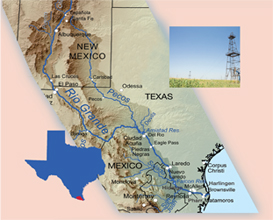In addition to the command center, Pharr invested $11 million to build a distribution center. The city broke ground in May 2013 on a 90-acre tract of land, which it subdivided into 31 two- and three-acre lots. Known as the Pharr Produce District, it is designed to offer growers and distributors amenities as well as convenience.
“What we’re proposing is for Mexican growers to expand operations to our side and to have in-and-out service that’s close to the Pharr International Bridge,” explains Bazán. “Our idea has been that if you build it, they will come,” referencing the famous line from Phil Alden Robinson’s popular 1989 film, Field of Dreams.
While several lots are already under contract at the new Pharr Produce District, construction and commitment has been slow. Given the cost of building and maintaining a warehouse, it could be a hard sell to some in the sector. Pedro Camacho, general manager of McAllen-based Traveler Produce, LLC, likes the idea of a produce park in general, and the location of this one in particular, but it’s also an investment of capital that could be spent in other areas of the business.
A Prime Location
Fixed costs notwithstanding, most agree the Valley is a good—many would say great—place to do business. It is the center of the state’s citrus production, which has a local economic impact of $150 million per year. While the region is known for oranges, watermelon, tangerines, tangelos, and Meyer Lemons, grapefruit, which accounts for more than 70 percent of the area’s total citrus production, is the dominant crop.
The Valley is strategically situated along the border, making it a very convenient point of entry for produce imports from both Mexico and Central America. In other words, location is key. “For a company like ours that imports 98 percent of its product from Mexico, there couldn’t be a better location than the Valley,” observes Yasmani García, sales representative at Sweet Seasons LLC in Hidalgo.
“For everybody in the United States who buys product from Mexico, this is one of the main places you can buy it. Plus, we can easily serve both the East and West Coasts,” García says, adding, “There’s a big difference between buying and transporting all the way from San Diego to New York than from the Valley to New York.”
Bret Erickson, president of the Texas International Produce Association (TIPA), concurs, pointing out that when it comes to imports, the Valley is a prime location. But he’s also quick to note the benefits of growing within the region itself. “We’ve got great growing conditions and a great climate, which makes it conducive to growing a variety of products,” he explains. “We’re on the receiving end of the pipeline for getting product from the West Coast of Mexico to the United States, and we have a rapidly growing population demanding more fruits and vegetables. That’s good for growers in Mexico and the Valley.”



